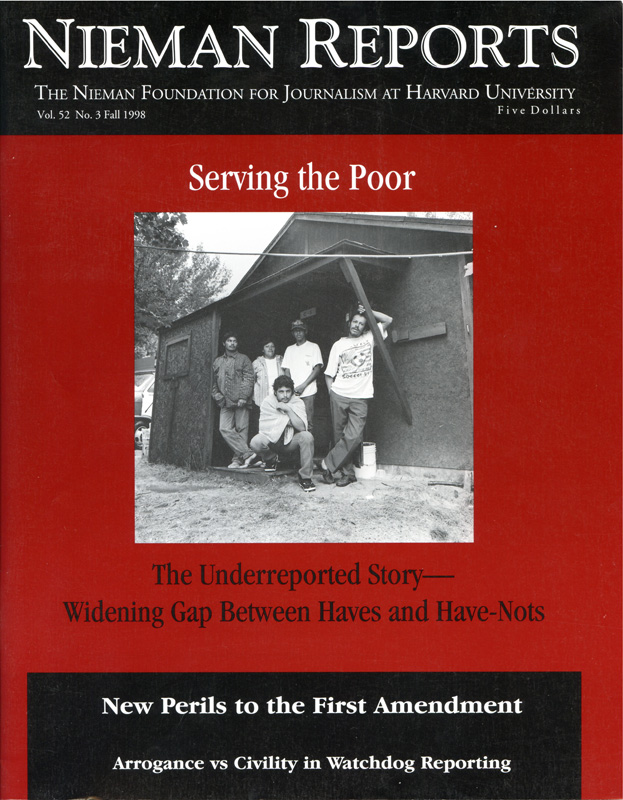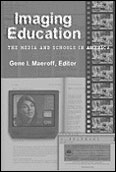In the winter 1997 edition of Nieman Reports, I issued the journalistic equivalent of a papal bull excommunicating most members of the print and visual media for all too often misunderstanding, misrepresenting and thereby severely damaging our American system of public education. These mortal sins, I alleged, added up to an unwarranted litany of superficial, endlessly negative, and almost always second-hand reporting about what is going on in our public schools. I was (and in no small measure still am) particularly concerned with what I feel to be two of the greatest weaknesses in the educational reporting that goes on in this country.
The first is the lack of on-the-spot, first-hand reporting about what is actually happening in the schools, including all of the frustrations and difficulties that both teachers and students are facing these days. The second (and perhaps even more devastating practice) is the sacred annual ritual of reporting the local (and, indeed, the national) school system’s standardized tests scores, in particular the habit of ranking and grading schools without taking into consideration the vastly different social, cultural, economic, racial and ethnic problems that different kinds of schools face. These differences are, of course, most pronounced for urban and rural as opposed to suburban schools, but they also appear within school districts, including suburban districts.
Now, as the result of two recent events, I am compelled to reappear before the ecclesiastical court of Nieman Reports in order, Galileo-like, to recant at least some portion of that diatribe.
The first event causing this partial mea culpa is the appearance of a front page report in the education world’s journal of record, Education Week, of June 17, 1998, by the journal’s senior editor, Lynn Olson, describing several path-breaking attempts to remedy both of these problems, but most especially the test score problem.
The second event is the appearance of a new book, published by Teachers College Press, edited by Gene I. Maeroff, formerly a national education reporter for The New York Times and now the director of the Fred M. Hechinger Institute on Education and the Media at Teachers College, Columbia University. In this book, called “Imaging Education: the Media and Schools in America,” some 19 educators, media people and even some innocent and not so innocent bystanders attempt to deal with the full range of the problems that exist between the media and the schools, very much including the two problems that are of greatest immediate concern to me.
To deal with the Ed/Week report first, Olson describes several path-breaking attempts on the part of some of the nation’s leading newspapers to dramatically upgrade their reporting of test scores. Take The Detroit Free Press, for example. Every year up to this year the paper would publish a list ranking school districts and schools solely on the basis of the raw, unexamined and unexplained scores of the state-wide tests conducted as part of the Michigan Educational Assessment Program (MEAP).
Worrying about this practice, the paper last year conducted an intensive six-month computer-assisted study of the test results, taking into account a variety of social and economic factors. The study found, says Olsen, that “poverty and other factors were so strongly linked to test scores that it made straight-up comparisons ‘inevitably flawed’ and ‘mostly meaningless.’ “I think we realized with some embarrassment,” Tracy Van Moorlehem, the paper’s education reporter, is quoted as saying, “that we never had any business ranking districts based on MEAP scores. It’s just not fair, nor really particularly accurate.”
To measure some of the effects of poverty and other non-school factors on achievement, The Free Press now uses such advanced statistical methods as multiple regression analysis to determine to what extent variations in test scores are related to such factors as family income, student mobility and limited English proficiency, all factors (along with many others) that have been demonstrated to be largely responsible for much of the test score differences between suburban middle and upper middle class students and students in our often under-funded, overcrowded and often far too large urban schools. When these factors are taken into consideration, it often turns out that schools with what appear to be low test scores are actually doing a better job of educating their assigned clientele than schools with higher test scores.
Many other newspapers, I am happy to say and thus be proved wrong in my papal bull, such as The Charlotte Observer, The Arkansas Democrat Gazette, The Seattle Times and The Philadelphia Inquirer, are also joining in this spreading refusal to treat test scores at misleading face value. Many of these papers are producing annual special sections devoted to descriptions of what is going on in the schools—good things as well bad things—along with test score results.
But, as several of the authors in the Maeroff book are quick to point out, simply correcting the unfortunate malfeasance of inadequate test score reporting does not solve the larger problem of the media’s failure to adequately cover the field of education.
Indeed, Maeroff’s book is made up largely of chapters by educators complaining about all of the things the media fail to cover. Of the 19 authors, 15 are presently in the education business (now including Maeroff himself), one is neither an educator nor of the media (Deborah Wadsworth of Public Agenda), and only three are actually members of the press or visual media (John Leonard of The Nation, New York Magazine and CBS, Aleta Watson of The San Jose Mercury News and Rochelle Stanford of The National Journal.)
Thus the best that is said in this book in defense of the media—and especially the nation’s newspapers—is, first, that the public at large does not appear to demand in-depth coverage of education (except for school sports, of course) or read or look at such coverage when it does appear. And second, because of this lack of interest, the media find it difficult to devote large quantities of newsprint or television time to the subject.
Even if these media views of the public are true, they cannot, as the educators are quick to point out, be used as excuses for the fact that the media coverage that does appear is all too often slipshod, superficial and, worst of all, overly susceptible to promoting the “bad” news and ignoring anything “good.”
The test score debacle is only one instance, say the educators, of the fact that few newspapers have staff reporters and editors who are savvy enough about social science research to interpret such data properly, with the result that a distorted picture is given of how well our students are doing or not doing.
This general lack of sophistication about educational data, say the educators, reflects and is perhaps caused, in part, by what David C. Berliner and Bruce J. Biddle talk about in their chapter entitled “The Lamentable Alliance Between the Media and School Critics.”
After taking the media to task for reporting that is “biased in favor of the negative side,” that is “more critical than complimentary,” that is “simplistic and incomplete,” that “displays a lack of understanding of the complexity of school life,” and which “shows an appalling lack of understanding of statistics and social science research,
” Berliner and Biddle make their really serious charge: “The press seems either too scared, too controlled, or too uninformed to raise what we consider the most basic issue confronting education in the United States today—achieving a fair distribution of opportunities to succeed,” i.e., “an ignorance of the role of poverty as the root cause of many of the difficulties in our schools.”
All this may seem harsh, but in general I think the authors in this book are essentially on the right track. I would add only that all too often the media do not seem to be aware of the major trends that are under way in American education and find out about them only when they become inescapable. The best current example of such a trend is the growing opposition in many public school systems to the present authoritarian national education agenda of imposed “world class” academic standards and “high” stakes testing.
This small but rapidly growing movement advocates a dramatic democratization and decentralization of our hierarchical, authoritarian school systems, with the devolution of decision-making power down to the level of new, small, autonomous but strictly public schools that can be voluntarily chosen by both parents and professional staff. This movement is best exemplified by what is going on in Boston and New York as people in these two systems attempt to create such schools against the considerable odds of entrenched educational bureaucracies and local school systems that are hopelessly anachronistic and often antagonistic to change.
As the saying often goes, and as it just as often goes unheeded, this really is a book that everyone in the media and especially the newspaper business should read.
Evans Clinchy, a 1959 Nieman Fellow, is a Senior Consultant at the Institute for Responsive Education at Northeastern University in Boston.



